Do you have a question about the Hartmann Tensoval duo control and is the answer not in the manual?
Provides general information about blood pressure, including its significance and measurement.
Explains the meaning of systolic and diastolic blood pressure values and their units.
Highlights the critical role of regular self-monitoring for managing health and preventing risks.
Details the purpose of personal blood pressure profiles for treatment tailoring and health management.
Emphasizes consistency in measurement timing for accurate blood pressure monitoring.
Guide on how to properly insert and replace the device's batteries.
Instructions for setting the device's date and time for accurate record-keeping.
Key guidelines for accurate and reliable blood pressure measurement procedures.
Step-by-step instructions for correctly fitting the blood pressure cuff.
Explains how to save measurement results for different users.
Instructions on how to retrieve stored morning, evening, and average blood pressure readings.
Guide on how to remove stored measurement data for individual users or all data.
Procedure for using the device without storing measurements, for temporary users.
Crucial advice regarding medication, pregnancy, health conditions, and heart rhythm.
Advises on the impact of medications on blood pressure readings and consultation with a doctor.
Discusses blood pressure changes during pregnancy and the importance of monitoring.
Notes on how specific medical conditions may affect measurement results and doctor consultation.
Information on heart rhythm disorders and their potential impact on measurement accuracy.
Information on battery usage, power supply, and environmentally sound disposal methods.
Crucial safety precautions for operating the device, including handling and environmental safety.
Details the importance and process of periodic calibration checks for accuracy.
Step-by-step guide on how to perform a calibration check on the device.
Provides contact details for customer support and service inquiries.
Provides general information about blood pressure, including its significance and measurement.
Explains the meaning of systolic and diastolic blood pressure values and their units.
Highlights the critical role of regular self-monitoring for managing health and preventing risks.
Details the purpose of personal blood pressure profiles for treatment tailoring and health management.
Emphasizes consistency in measurement timing for accurate blood pressure monitoring.
Guide on how to properly insert and replace the device's batteries.
Instructions for setting the device's date and time for accurate record-keeping.
Key guidelines for accurate and reliable blood pressure measurement procedures.
Step-by-step instructions for correctly fitting the blood pressure cuff.
Explains how to save measurement results for different users.
Instructions on how to retrieve stored morning, evening, and average blood pressure readings.
Guide on how to remove stored measurement data for individual users or all data.
Procedure for using the device without storing measurements, for temporary users.
Crucial advice regarding medication, pregnancy, health conditions, and heart rhythm.
Advises on the impact of medications on blood pressure readings and consultation with a doctor.
Discusses blood pressure changes during pregnancy and the importance of monitoring.
Notes on how specific medical conditions may affect measurement results and doctor consultation.
Information on heart rhythm disorders and their potential impact on measurement accuracy.
Information on battery usage, power supply, and environmentally sound disposal methods.
Crucial safety precautions for operating the device, including handling and environmental safety.
Details the importance and process of periodic calibration checks for accuracy.
Step-by-step guide on how to perform a calibration check on the device.
Provides contact details for customer support and service inquiries.
| Device Type | Upper Arm Blood Pressure Monitor |
|---|---|
| Measurement Method | Oscillometric |
| Display | LCD |
| Memory | Yes |
| Average Value Display | Yes |
| Arrhythmia Detection | Yes |
| Irregular Heartbeat Detection | Yes |
| WHO Indicator | Yes |
| WHO Classification Indicator | Yes |
| Power Source | Batteries |
| Automatic Shut-off | Yes |
| Bluetooth Connectivity | No |
| Cuff Size | 22 - 42 cm |
| Number of Memory Slots | 2 |
| Power Supply | 4 x AA batteries |
| Technology | Duo Sensor Technology (combination of oscillometric and Korotkoff method) |
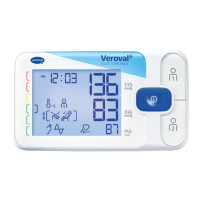
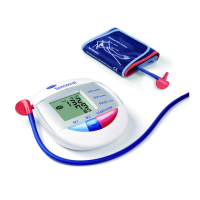

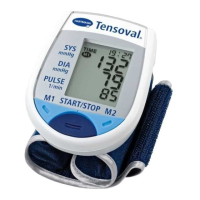

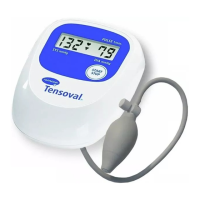
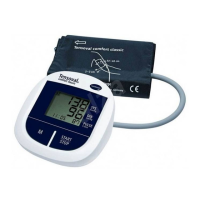

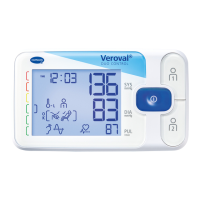
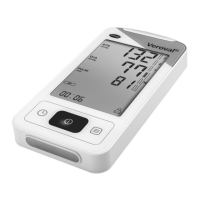
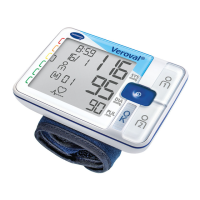
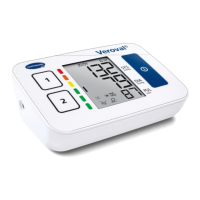
